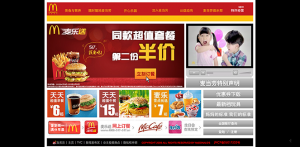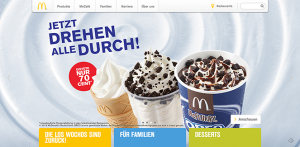With Yahoo!
acquiring Tumblr and re-vamping Flickr, I had a discussion with Garrett about what Yahoo!
has to offer outside of these two websites. I then mentioned that Yahoo!
is used more often in East Asian cultures (especially Yahoo! Japan and Yahoo! Taiwan). Some other websites that are used heavily in East Asia include baidu.com, qq.com, taobao.com, and sina.com.cn -- all of which are quite content-heavy in the
homepage, as compared to the clean and simple interface of Google.com that is used more often in North America. Why is there a huge difference in usage? Well, there are differences with regards to designing amongst cultures. Here are a few things that
UX Magazine had mentioned to consider when designing with cross-cultural differences in mind.
LANGUAGE
Direct translation of content from language to language isn't that simple (as we've all experienced with Google Translate). There are certain keywords or phrases that are used in other languages. For example, in French, the direct translation of "car insurance" would be "
l'assurance automobile." However, the most popular keyword search for this is "
auto assurance." We must keep in mind the different slangs, phrases, and keywords that are used amongst different cultures.
COLORS (or to me, "Colours")
Colors can influence our instinctive reaction to places, products, or even people. When we see blue, we usually associate this with calmness,
trust, devotion, intelligence, and truth (hence why a lot of banks use this color). Red triggers a response in the pituitary gland, therefore, evoking strong emotions, such as passion, intensity, or even
aggressiveness. Red, in most Western cultures represents
danger or an action. However, in Chinese culture, red is associated with luck and prosperity; in South Africa, it is a color of mourning.
HIGH & LOW CONTEXT
Anthropologist and cross cultural researcher,
Edward T. Hall, developed a concept identifying the styles in which cultures communicate. High context (a.k.a.
polychronic) cultures, such as China and Japan, are usually relational, collectivist, and intuitive cultures. Words are as important as context, therefore they communicate through implicit ways or in indirect ways. Therefore, they place more importance in other communicative devices, such as body language or tone of voice. In design, high context cultures communicate through multiple areas of focus, as there is hardly any context, and try to make up for it with more text. China's McDonald's website is full of color with multiple areas of focus. Furthermore, in high context cultures, people are featured as much as the product.

Low context (a.k.a.
monochronic) cultures, such as North America, are usually logical, individualistic, and action-oriented. People tend to communicate through clear, direct, explicit statements. In user interface design, low context cultures tend to respond to one thing at a time and detail on a product, by putting their message across in an effective manner using minimal text. Low context cultures tend to respond to one thing at a time. As you can see, the McDonald's German website is
minimalistic with a large emphasis on their product.

WHAT DOES THIS MEAN?
When designing something, we can't just simply use the same template and translate the content. User research is imperative, especially if we are designing for different cultural groups. We have to keep in mind that we are designing for the user and his/her context.